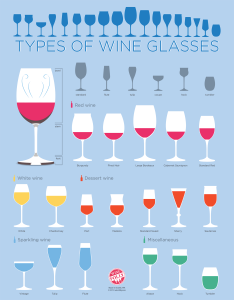We all know wine is subjective, driven by opinion and taste and balanced out by knowledge and experience. So also, it seems, is the topic of wine glasses. Which glass shape is the best for which wine type or style? Do expensive, exquisite crystal glasses improve the experience above supermarket cheapies? Is there an actual effect or is it all about perception? There are as many opinions on this matter as there are shapes and types of glasses. Where do we even begin?

An Infographic illustrating types of wine glasses (via http://winefolly.com/tutorial/types-of-wine-glasses/)
A simple Google search will produce a mountain of results describing types of wine glasses, categorised for white wine, red wine, dessert wine, sparkling wine and others. The above infographic is a great little at-a-glance summary. So, why all the different shapes? And why match them with specific types of wine? Hard, irrefutable scientific evidence is scarce and flaky at best on this topic, but we’re pretty much OK with that. Science is great but in the end it comes down to your experience and not a study in some obscure journal. One fact that seems obvious and logical is the effect of the stem on the glass. Stemware allows the drinker to hold the glass without touching the bowl and increasing the wine temperature.
The general theory seems to be that the shape of the glass affects how the aromas from the wine reach your nose, thereby impacting how you experience the wine. Red wine glasses have a bigger bowl, which is thought to assist oxidation and opening up the wine. White wine glasses are comparatively smaller, as preventing rapid oxidation can help preserve a fresher flavour of delicate whites.
Dessert wines are served in small glasses. They generally have a very high alcohol content, so smaller serving glasses are desired but it may also be that the small glass directs the liquid further back onto the tongue, lessening the burning effect of the alcohol and increasing the perception of the sweetness.
For champagne glasses the popular choices are the flute or the coupe. The coupe is not as fashionable as it was a few decades ago but is still available. It was especially suited to build champagne towers as they shape allowed the flowing of the bubbly from the top, single glass into all the other in a rather spectacular fountain. The story goes that the original coupe design was shaped on the breast of Marie Antoinette, Madame de Pompadour or a number of other French aristocratic ladies of the time. While this is probably more fantasy than fact, tis a fabulous little tidbit.
The problem with the coupe is that the bubbly loses carbonation quite quickly because of the large surface area. The flute is seen as more elegant and sophisticated nowadays and is much preferred to the coupe. The narrow bowl also retains the carbonation more effectively, keeping your bubbly bubbling for longer and keeping bubbly lovers delighted.
But what about lead crystal vs. glass? Crystal is glass with lead monoxide added to it. This increases the refractory index of the glass. Simply put, it makes it more shiny and sparkly. Lead-free glassware is enhanced by the addition of alternative to lead monoxide, such as zinc- or magnesium oxide.
So where does that leave us in the great glassware debate?
With modern technology improving glassmaking techniques and modern trends affecting our tastes and designs, the choice of glassware available to wine drinkers today is expansive. Coloured glass, etched, embellished, stemless, oddly shaped or classic styles. You can buy them in boxes of 12 for a steal at your local shop or you can import them at eye-watering prices from the best glassware manufacturers in the world. But does it make a difference? That’s probably up to you. Sommeliers, Masters of Wine and other learned wine fundis are likely to insist it makes all the difference. If your nose isn’t quite as sensitive as theirs or your palate as particular, chances are the type of glass you use won’t affect your experience that much, if at all.
So try before you buy, see which you prefer and make sure they’re always filled with good wine.


Pingback: Let’s Talk About Champagne Glasses |
I once attended a Creation “What’s in a glass” event – designed to show you how wine differs depending on the glass you taste it in. My anti-snob meter was at an all time high – but I kid you not. I was BLOWN AWAY. Put a chardonnay in once glass, tastes amazing – put it in another glass – tastes AWFUL. Same with Pinot Noir. If you’ve got the wallet, investigating those specific Riedel glasses for your favourite varietals is highly recommended.